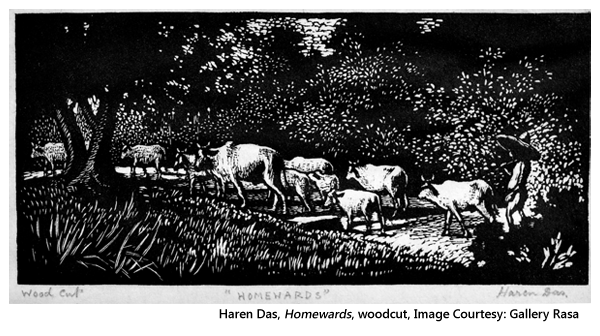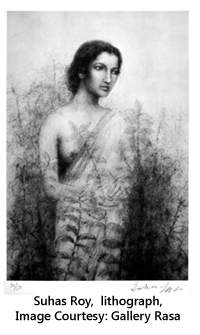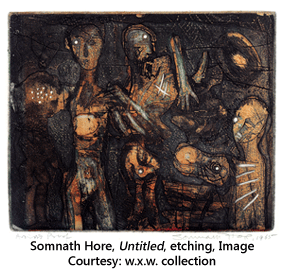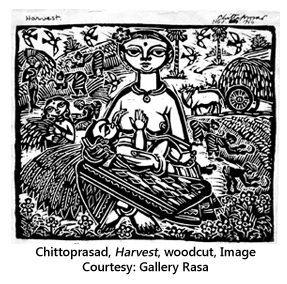- Publisher's Note
- Editorial
- Love of Life (that) Spills Over
- A Continuing Multiplication
- From Painting to Print
- Intimate Involvement
- Portrait of the Artist as an Old Man
- (Hi)Story of the Garhi Printmaking Studios, New Delhi
- Surinder Chadda
- Ramendranath Chakravorty
- Group 8
- Mother and Child: A Screenplay
- Straddling Worlds
- A Brief History of Printmaking at Santiniketan
- Vignettes from History
- Southern Strategies
- The Forgotten Pioneer: Rasiklal Parikh
- Printmaking in the City Of Joy
- Amitabha Banerjee: His Art and Aesthetic Journey
- Local Style and Homogenizing trends: Early Medieval Sculpture in Galaganatha
- English China: Delicate Pallid Beauty
- The Beauty of 'Bilal'
- Photo Essay
- The Way of The Masters: The Great Artists of India 1100 –1900
- Striving Towards Objectivity
- The Art of Sculpting In the Contemporary Times
- An Artistic Framework for an Alternative to Ecology
- Bidriware and Damascene Work in Jagdish and Kamla Mittal Museum of Indian Art
- A Lowdown on the Print Market
- The 'bubble' and the 'wobble'
- What Happened and What's Forthcoming
- Art Bengaluru
- Art Events Kolkata: June – July 2011
- Musings from Chennai
- Mumbai Art Sighting
- Previews
- In the News
- Christie's Jewellery Auction at London, South Kensington
ART news & views
Printmaking in the City Of Joy
Volume: 3 Issue No: 19 Month: 8 Year: 2011
by Sarmistha Maiti

The history of printmaking is long and varied in India and dates back to the late 1700s. From the early years Kolkata remained the initiator in the aesthetic propagation of this form of visual art, and Kolkata has produced some of the finest works of art in India's printmaking history.

An album called Twelve Views of Calcutta was published in the 18th century that was a compilation of prints. The tradition was further enhanced with the settlement of various foreign artists on the banks of the Hooghly River who were mostly engravers and etchers. Joseph Sheppard, John Garbrant, William Daniell, Richard Brittridge, James Moffat, Thomas Taylor, Henry Hudson, William Bailie, Avon Apjon, John Brown, John Alefounder, Samuel Davis, Francis Dormieux were the prominent names in this field. Throughout the 18th and the 19th century, India tried to adopt and assimilate printmaking as a part of its indigenous culture of art in an attempt to make it truly of its own.
The 20th century saw the rise of some prominent printmakers from the capital district of West Bengal where the benchmark had already been established in the first half of the last century during the colonial period. Post-Independence India saw the art of printmaking at its zenith, complying with a language of its own. The prominent names of Kolkata printmakers in the last century who laid the paving stone in this form of art after independence would be Haren Das (1921-1993), Chittoprasad (1915-1978), Arun Bose (1934- 2007), Somnath Hore (1921-2006), Amitabha Banerjee (1928),  Suhas Roy (1926) and Lalu Prasad Shaw (1937). The last five names in the list also belonged to the Society of Contemporary Artists that played a big role in setting a new discourse in the art world and its sustainable potentiality over a period of fifty years. The Society had a strong interest in the propagation of printmaking, and some works by artists associated with the Society have become a recognized pinnacle of graphic art in Indian art history.
Suhas Roy (1926) and Lalu Prasad Shaw (1937). The last five names in the list also belonged to the Society of Contemporary Artists that played a big role in setting a new discourse in the art world and its sustainable potentiality over a period of fifty years. The Society had a strong interest in the propagation of printmaking, and some works by artists associated with the Society have become a recognized pinnacle of graphic art in Indian art history.
The journey of printmaking in this part of India developed around socio-political conscientious ground. The artists' deep concern for contemporary society and its malice got introspected and represented in their works of art. Chittoprasad was one of the most socially involved artists of the last century. His main area of expression was through caricatures, sketches and prints and he is probably most remembered for his depictions of the Great Famine of 1943. Generally when one attempts to depict a social concern, a social loss or a social disaster, a blend of empathy  and apathy comprise to hold the essence of such issues. Chittoprasad was a step ahead of this. He combined satire, mock elements and the touch of sensibility conjugated together to invoke the variable layers of thought-process a work of art is able to execute, with minute detailing that took the realistic appeal of the prints to a higher order of aesthetics.
and apathy comprise to hold the essence of such issues. Chittoprasad was a step ahead of this. He combined satire, mock elements and the touch of sensibility conjugated together to invoke the variable layers of thought-process a work of art is able to execute, with minute detailing that took the realistic appeal of the prints to a higher order of aesthetics.
Rural Bengal in woodblock printing was what Haren Das could create magic with. Through true indigenous appeals to the mundane sentiments of society's rural roots, Haren Das transcended simplified depictions of village scenes to create prints with a story-telling mode of narrative. For Arun Bose, mysticism and mythical anecdotes took over mundane tales in his coloured aquatint etchings. Bose was abstract in his representation. He said, “Shadow is much more mysterious than life. If I see life, I see everything. But if I see shadow, only the silhouette - the rest you imagine. I like mystery.”
Lithography and intaglio became Somnath Hore's major areas of printmaking, which he pursued in equal measure along with sketches and sculpture. Hore's drawings and his Tebhaga series of woodcuts that he had executed right after independence show the influence of Chinese Socialist Realism and German Expressionism. He was also influenced in his youth by the robust style of German printmaker Käthe Kollwitz and Austrian Expressionist Oskar Kokoschka. Hore evolved as a figurative artist and especially his human figures became simplified and shed details both in his drawings and prints. He attained his individual style of twisted and suffering figures… created with a masterly use of line from his drawing skills… with simplification. His Wounds Series of paper pulp prints can be considered as the highest point of his artistic career, where he achieved a unique brand of abstraction without sacrificing his long-practiced humanism.
Amitabha Banerjee, Suhas Roy and Lalu Prasad Shaw, who were also the members of Society of the Contemporary Artists, continued with their creative journey in different forms of art of which printmaking remained a strong focus. If Chittoprasad, Haren Das and Somnath Hore would be considered as maestros of printmaking as a social narrative, Suhas Roy, Lalu Prasad and Amitabha Banerjee are to be regarded more in the line of an inward journey of the reflections of human emotions with both earthly and mystic feelings gratified with the touch of Romanticism.